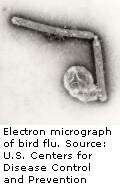Most Chinese patients with confirmed avian influenza A are critically ill and 21 percent have died, according to a preliminary report published online April 24 in the New England Journal of Medicine.
(HealthDay)—Most Chinese patients with confirmed avian influenza A (H7N9) are critically ill and 21 percent have died, according to a preliminary report published online April 24 in the New England Journal of Medicine.
Qun Li, M.D., from the Public Health Emergency Center in Beijing, and colleagues characterized the epidemiologic characteristics of 82 H7N9 cases in China as of April 17, 2013, using data obtained from field investigations. The presence of the virus was verified among cases by real-time reverse transcriptase-polymerase-chain-reaction, viral isolation, or serologic testing.
The authors found that the cases (age 2 to 89 years; 73 percent male; 84 percent urban residents) with confirmed H7N9 virus infection were identified in six areas of China. Four of the 77 cases with available data were poultry workers and 77 percent had a history of exposure to live animals, mainly chickens (76 percent). After a median duration of 11 days, 17 patients died (21 percent); 60 patients remained critically ill; four clinically mild cases were discharged from the hospital; and one pediatric patient was not hospitalized. Human-to-human viral transmission could not be ruled out in two family clusters. A seven-day monitoring period was completed for 1,251 of the 1,689 close contacts of case patients. Of these, 19 developed respiratory symptoms but all were negative for H7N9.
"Most persons with confirmed H7N9 virus infection were critically ill and epidemiologically unrelated," the authors write. "Laboratory-confirmed human-to-human H7N9 virus transmission was not documented among close contacts, but such transmission could not be ruled out in two families."
More information: Full Text
Journal information: New England Journal of Medicine
Health News Copyright © 2013 HealthDay. All rights reserved.


















